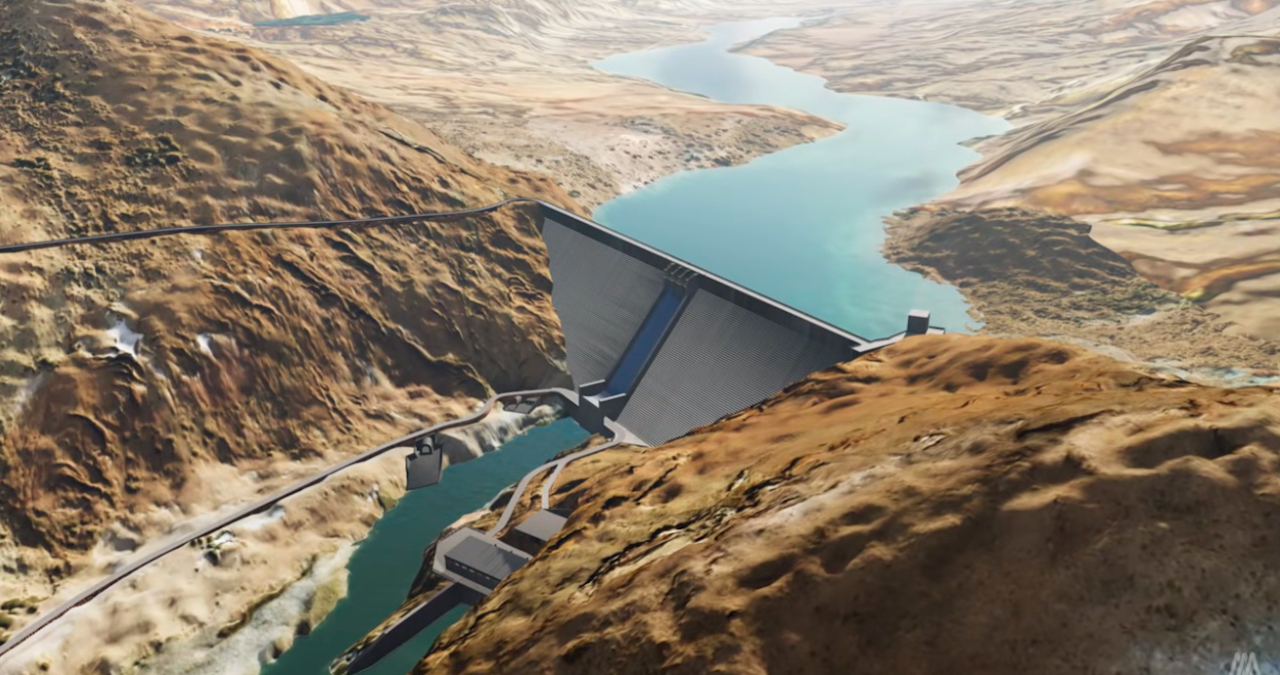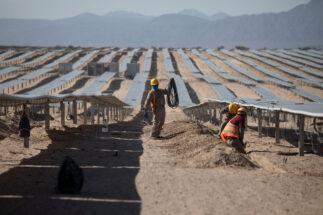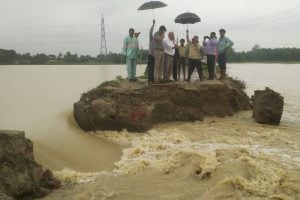After fits and starts that date back to the 1950s, Argentina’s Mendoza province is preparing to make the Portezuelo del Viento mega-project a reality. The dam in the west of the country promises energy, tourism and jobs. However, it is a source for conflict with other provinces and social organisations, who fear they will run out of water.
The dam will be located on the Rio Grande in the department of Malargüe, 300 kilometres from the border with Chile. Its projected height is 185 metres and its reservoir capacity 2,000 cubic hectometres. The project’s generating capacity will be 210MW, sufficient to power 130,000 homes.
In addition to the hydroelectric plant, the project involves laying an electric power line, the construction of new sections of National Route 145, which links Argentina and Chile, and Provincial Route 226, and the construction of a new Villa Las Loicas village, since the original will be flooded.
Despite opposition from the government of neighbouring La Pampa province, Mendoza is moving forward with the bidding process. Only a consortium led by the Chinese state-owned company Sinohydro that includes three home-province companies (IMPSA, CEOSA and Obras Andinas) has presented a proposal.
Did you know…?
Sinohydro's parent company PowerChina is developing energy projects in more than 80 countries
Sinohydro belongs to the Chinese state-owned PowerChina, one of the biggest energy and construction companies worldwide with projects in 80 countries. In Argentina, it’s currently building the El Tambolar hydroelectric dam in the nearby province of San Juan and its renewable energy portfolio includes Cauchari, the largest solar project in Latin America.
“The dam will be located in Mendoza but it’s of federal importance as it generates clean energy for more than 100 thousand families in other provinces,” said Mario Isgro, Mendoza’s minister of planning and public infrastructure. “The dam will also regulate the availability of water downstream. It’s important for the entire basin.”
For Isro, the project “will be an important generator of direct employment at the time of construction and during operation, and will create indirect jobs with the activities that may take place in the reservoir’s lake”. He described the area where the dam will be located as a ‘very beautiful place’ for tourism and sports activities.
Portezuelo del Viento: A 100-year old conflict
Although Portezuelo del Viento will be located in Mendoza’s territory, the Grande river, on which the dam will be built, is the main tributary of the Colorado river, an important watercourse that runs for 1000 kilometres from the Andes to the Atlantic and crosses five provinces: Mendoza, La Pampa, Neuquén, Río Negro and Buenos Aires.
La Pampa is opposed to the project precisely because it fears that the dam will reduce the flow of the Colorado River in its territory. “The central concern of La Pampa province is that Portezuelo del Viento will affect the quantity and quality of water in the Colorado basin,” says Néstor Lastiri, La Pampa’s secretary of water resources.
The province has already initiated several legal actions against Mendoza and is demanding an environmental assessment throughout the entire Colorado River basin. Lastiri caims that Mendoza is not complying with national laws on water management.
It will reduce the flow of a river that is fundamental for us by 70%. We live off the river and we need the water to survive
The conflict is not new. One hundred years ago, a series of works in Mendoza considerably reduced the volume of water in La Pampa. These included the construction in 1947 of the El Nihuil dam, which led to the disappearance of the major branches of the Atuel River in La Pampa, forcefully impacting the nearby ecosystem and commercial activities.
Nor has Argentina avoided conflicts over mega dams in more recent times. Social and environmental organisations have strongly opposed the construction of the La Barrancosa-Cóndor Cliff hydroelectric complex on the Santa Cruz River in its eponymous southern province. The project is 85% financed by China Development Bank (CDB) and will be executed by Chinese company Gezhouba Group, along with local firms.
Presidential decision
The five provinces that the Colorado River bisects manage it through the Colorado River Interjurisdictional Committee (COIRCO). Its rules mandate that in the event of a disagreement on issues between the provinces, Argentina’s president assumes the role of arbitrator.
In June, when La Pampa demanded that an Environmental Impact Assessment (EIA) be carried out not just in Mendoza’s territory but in the entire Colorado River basin it was backed by all the other provinces.
President Alberto Fernández must now decide whether to side with Mendoza or order a new study for the entire river basin.
Criticism of Portezuelo del Viento
The People’s Assembly for Water of Mendoza, a citizens’ group, supports La Pampa’s demand for a cross-provincial environmental impact study.
“The dam will significantly affect the flow of the Colorado River, which already has a low flow rate. The provinces are suffering from a water crisis that has been aggravated by climate change and this project will make it worse,” said Elsa Díaz, a representative of the Assembly.
For Díaz, Portezuelo del Viento does not qualify as clean energy, but rather part of an ‘extractivist’ model as the energy generated would be used to power new mining and oil projects. “The communities that live on the banks of the Colorado River already have problems with the water crisis… if they run out of water because of this project, their livelihoods will be affected,” she adds.

Melisa Ibañez of the Permanent Assembly for the Colorado River, another citizen group, has a similar view. She says Portezuelo del Viento is “a project without a social license”.
“It will reduce the flow of a river that is fundamental for us by 70%. We live off the river and we need the water to survive. The Colorado is tourism and it is agriculture. We drink from this water and produce food. It’s also going to affect the fauna,” Ibañez laments.
Ibañez’s organisation argues that the impact assessments that were carried out are old. “They were done on the flow of a river that no longer exists,” says Ibañez, referring to the lesser availability of water that climate change threatens to prolong and deepen.
The Union of Workers of the Earth (UTT), a nationwide organisation of small agricultural producers, also opposes Portezuelo del Viento.
“We already have problems with irrigation, and in the south of Buenos Aires [Province] there are 45,000 hectares less production due to the water crisis. In this context, the dam is going to hurt us enormously,” says Karina Zon, of the Rio Colorado UTT.
Zon and other environmentalists also criticise a plan to transfer water from the Grande River to the Atuel, which would combine with Portezuelo del Viento to further reduce the flow of the Colorado. Zon claims Mendoza’s government has not been transparent about the project.
“There is concealment of part of the project that would affect all the downstream provinces, both in terms of irrigation and human consumption, because by reducing the flow, the concentration of salts harmful to consumption and crops increases,” Zon explains.
Mendoza’s view
The government of Mendoza contests environmentalists’ and small producers’ versions of events and says that Portezuelo del Viento will actually improve the availability of water for the entire basin. Furthermore, it says that all environmental impact studies necessary for the project were carried out.
“The other provinces will not run out of water. On the contrary, the reservoir is a water reserve for when nature cannot provide it. And it is important to say that the management of the water output from the dam is undertaken jointly by COIRCO,” Isgro says.
Isgro also says Sinohydro’s interest in constructing the dam attests to its strong rationale: “The decision to participate from a company like that is a message that the work is well planned. Sinohydro has a lot of experience in this type of construction and took nine months to study the tender documents. That’s very auspicious,” he reasons.
Eduardo Moreno, an engineer from the National University of Cuyo, who was in charge of the environmental impact study, said that the dam was “studied very carefully” from an environmental point of view. He ruled out the possibility of water shortages. “There are management plans for different scenarios – a lot of water or a shortage,” he says.
Moreno says another benefit of the dam is that it will prevent the emission of 300,000 tonnes of carbon dioxide per year: “As it is a project in the middle of the desert, which does not compete with other productive activities and is without significant flora and fauna, the balance is tremendously positive in environmental terms.”








